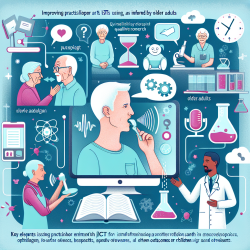Introduction
In the realm of speech-language pathology and online therapy, understanding how different populations perceive and utilize technology can significantly enhance the effectiveness of therapeutic interventions. A recent qualitative study titled How Prefrail Older People Living Alone Perceive Information and Communications Technology and What They Would Ask a Robot for: Qualitative Study provides valuable insights into the perceptions of prefrail older adults towards Information and Communications Technology (ICT) and robotics. Although the primary focus of the study is on older adults, the findings can be extrapolated to improve outcomes in pediatric therapy settings as well.
Key Findings from the Study
The study reveals that older adults, even those who might initially perceive themselves as technologically inept, often use ICT devices like smartphones and computers in their daily lives. Notably, their openness to technology is not strictly correlated with their educational background or age, challenging some common assumptions. This indicates that attitudes towards technology can evolve with exposure and necessity.
Furthermore, the study highlights that older adults are receptive to the idea of robots assisting them with daily tasks such as housekeeping, health monitoring, and providing companionship. This openness suggests a potential for integrating similar technologies into therapy practices for children, where robotic aids could be used to support learning and communication.
Implications for Practitioners
Practitioners in speech-language pathology and online therapy can draw several lessons from this study:
- Customization and Flexibility: Just as older adults express diverse needs and preferences for ICT, children in therapy can benefit from personalized technological interventions. Practitioners should consider customizing digital tools to meet the specific needs of each child.
- Encouraging Technological Engagement: Encouraging children and their families to engage with technology in a positive manner can enhance therapy outcomes. This includes introducing user-friendly apps and devices that facilitate communication and learning.
- Utilizing Robotics: The study's findings on the acceptance of robots for companionship and assistance can inspire practitioners to explore robotic tools in therapy. Robots can be used to simulate social interactions, provide feedback, and engage children in interactive learning experiences.
Encouraging Further Research
While the study provides valuable insights, it also opens the door for further research into the application of ICT and robotics in pediatric therapy. Practitioners are encouraged to explore how these technologies can be tailored to support children with diverse needs, particularly in remote or underserved areas where access to traditional therapy may be limited.
Conclusion
The study on older adults' perceptions of ICT and robotics offers a fresh perspective on how technology can be integrated into therapeutic practices. By understanding and applying these insights, practitioners can enhance their skills and improve outcomes for children in therapy. To read the original research paper, please follow this link: How Prefrail Older People Living Alone Perceive Information and Communications Technology and What They Would Ask a Robot for: Qualitative Study.










